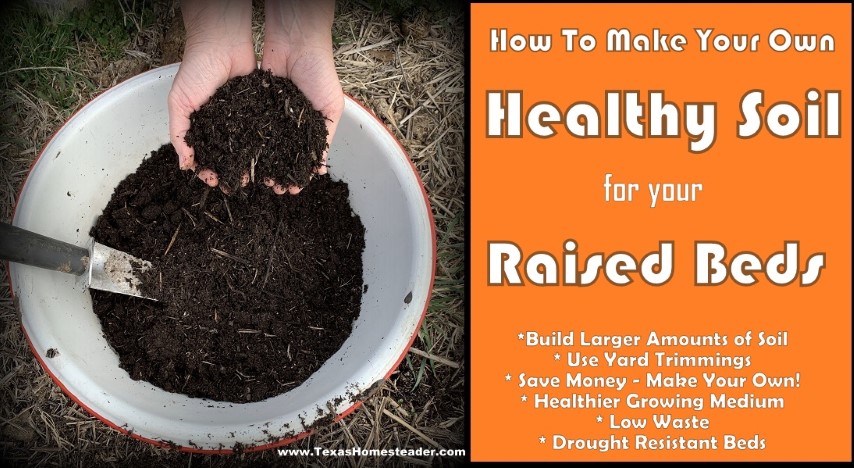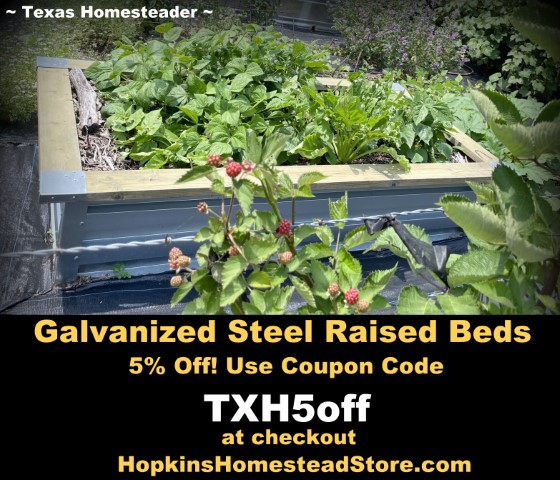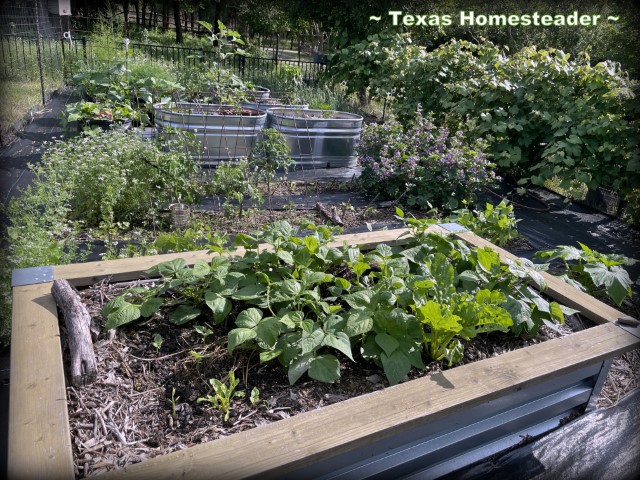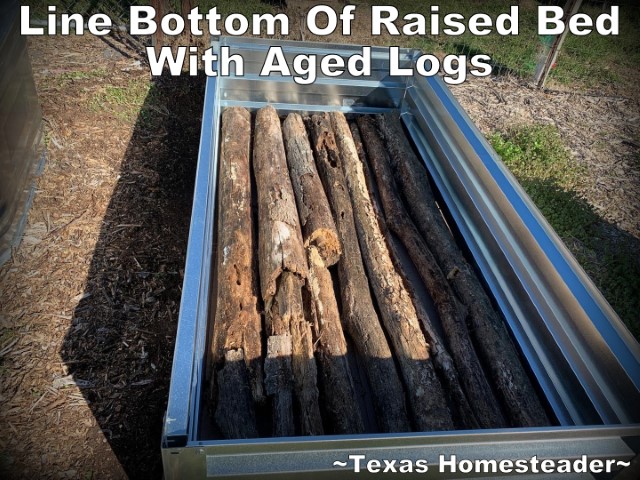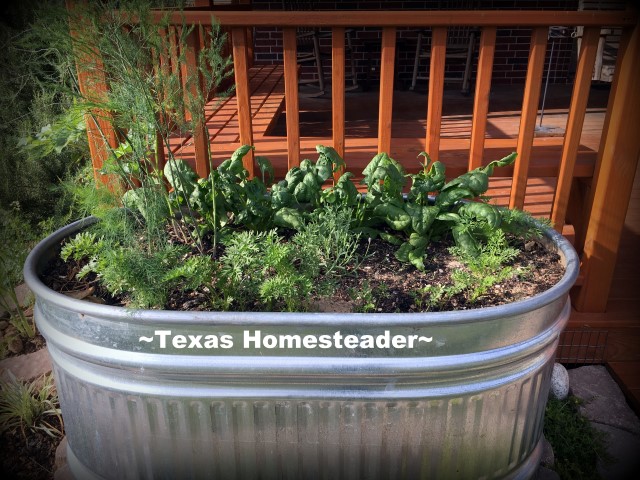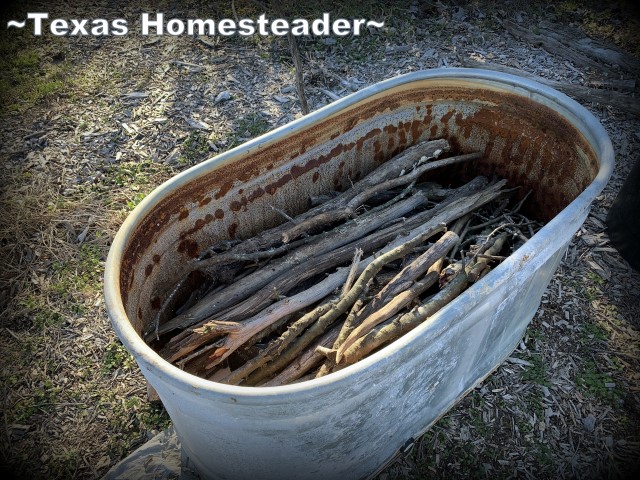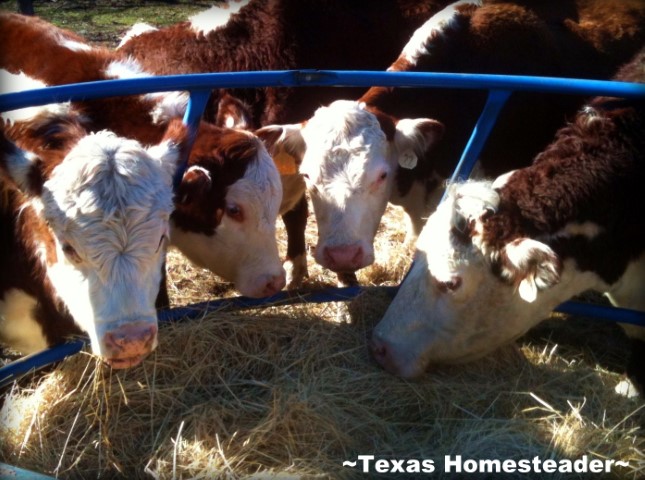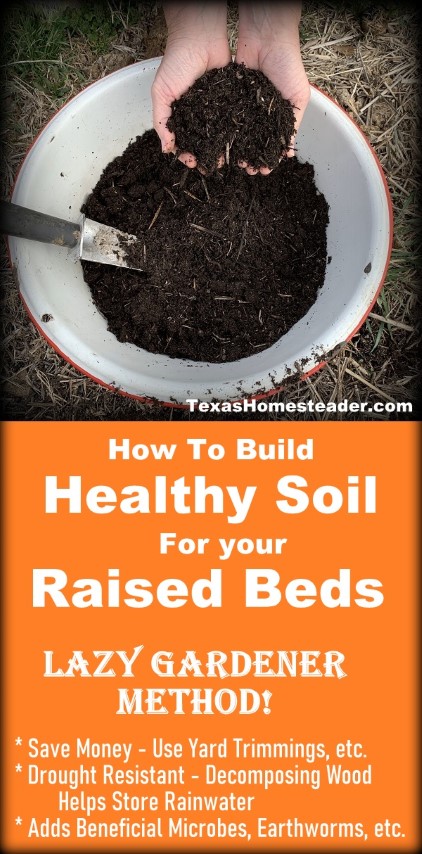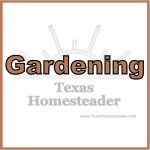by Texas Homesteader ~
You can make your own garden soil using natural methods such as Hügelkultur or lasagna sheet mulching styles. There are many benefits such as significantly reduced costs, easier maintenance, increased soil fertility & drought resistance. Don’t worry, it’s EASY!
Building Your Own Garden Soil
It’s true you can build your own healthy, productive soil for raised beds by simply layering different degradable materials. You’ll use the same greens/browns list I’ve shared in my Compost Guide.
When building soil by layering these materials such as with Hügelkultur or lasagna gardening, there are many benefits.
- Cheaper Raised Bed Filling – Use what you already have such as woody debris from downed trees, limbs, trimmings, leaves, grass clippings, wood chips, etc.
- Low Maintenance, No-Till beds are an easy way to improve beds on compacted, heavy clay, or poor soil.
- Better Water Retention – Decomposing wood at the bottom of the pile will soak up moisture & deliver it to the plant’s roots during drier times.
- Build Fertility – Attracts earthworms, beneficial fungi & bacteria, healthy microbial activity, etc.
What Are The Benefits Of Layering Soil Components?
The benefit of layering materials this way is that over time it all degrades. That will attract all the good stuff you want in your garden soil – beneficial bacteria & fungi, earthworms and that all-important microbial activity.
They’ll all work for FREE to make a more productive garden for you!
And the decaying wood helps these beds to be more drought resistant since it holds moisture and releases it to the plant’s roots during drier times. That’s a big bonus here in NE Texas during those hot & dry summer months!
What Is Sheet Composting / Lasagna Layering?
I’ve used Lasagna Gardening (also known as Sheet Composting) for garden rows & shorter raised beds. It’s simply layering composting ‘browns’ and ‘greens’ in planting rows.
Start with cardboard to smother out any weeds.
Add small twigs & leaves.
Layer browns and greens in alternate layers.
Be sure to pack the layers as tightly as you can, packing more finely textured items into the crevices. And water each layer thoroughly to get the rotting process started as soon as possible.
Sheet composting is best started the previous year in late summer or fall so materials will decompose for spring planting.
This material will break down into healthy soil. In the spring you just top with finished compost mixed with soil & plant!
Hügelkultur Garden – What Is It?
Hügelkultur translates to “mound culture” and is similar to lasagna gardening or sheet composting, but in a bigger form. Instead of starting with twigs and leaves for your base, you’re actually starting with logs.
The premise of Hügelkultur is that plants are grown in tall raised mounded beds made of layers of botanical matter.
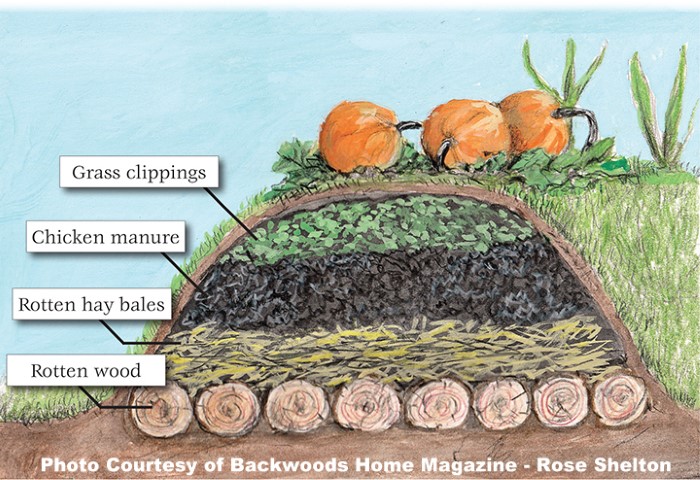
Photo courtesy of Backwoods Home Magazine & Rose Shelton
Texas A&M University says:
“Hügelkultur, German for “hill culture,” is the practice of composting large woody material, such as tree logs, to create a raised garden bed, said Masabni, who is based in Overton. Other excess garden waste, including prunings, hedge clippings and brushwood can be utilized to create the no-till bed for plants.”
How To Build Hügelkultur Bed Layers:
According to permaculturenews.com, the layers you want for Hügelkultur are:
-
-
- Larger Logs
- Smaller branches
- Small sticks or twigs
- Leaf litter
- Grass clippings or manure (nitrogen rich to offset nitrogen loss)
- 1-2 inches topsoil
- Layer of mulch
- You can plant immediately, but this type of garden benefits from building several months in advance of planting to get it started curing and that wood degrading.
-
Combination of Sheet Composting & Hügelkultur Methods
For my taller open-bottom raised bed I use a combination of sheet composting & Hügelkultur styles. Instead of twigs I’ll start with actual logs at the bottom and build the layers from there.
Then I’ll continue layering up to the top of my raised bed. But the layers will end up flat & not as a mound as traditional Hügelkultur would, nor will I utilize mound planting.
Making Soil For A Large Raised Bed
I recently obtained a couple of large open-bottom raised beds. (Oh man, I *LOVE* these Heavy-Duty Metal Raised Beds, y’all!)
Using larger logs in this bed significantly reduced the amount of money I would need to spend filling it with purchased soil. Here’s what I did:
Start with cardboard to smother weeds.
Top with long straight logs. Fill in any gaps with wood mulch. (see note below for wood-variety tips)
Add small twigs & leaves, packing tightly.
Layer 3″ of greens such as untreated grass clippings, animal bedding, coffee grounds, manure, etc. on top of the wood, followed with 3″ of browns such as cured grass cuttings, untreated straw, newspaper, etc.
Repeat Layers of smaller browns and greens in alternate layers.
Top with garden soil/compost for planting
NOTE: If I’ve started layering in the fall I only top with a few inches of planting soil since decomposition is already well on its way. If I get a later start on layering I’ll add about 10″-12″ of planting soil to keep plant roots away from ‘hot compost’. So start that layering early, y’all!
Tips For Layering Raised Bed Soil:
- Combatting Nitrogen Loss – The decomposing wood initially robs nitrogen from the surrounding soil. Be sure to top wood with a nitrogen-rich layer such as manure or grass clippings when building beds. I also plant green beans that first year to offset nitrogen loss since beans are legumes & make their own nitrogen.
- Slow-Rotting Wood – Don’t use slow-rotting woods such as cedar, locust, Bois d’Arc, etc. The decomposing wood is part of your bed’s healthy soil!
- Wood with Toxins – Some tree wood releases toxins to inhibit plant growth. So wood from black cherry, black walnut or treated lumber should not be used
- Soil Level Falls Each Year – As the bulkier components at the bottom of the pile decompose the level of soil in your raised bed falls. You’ll need to top off your layered garden with more soil/compost each year.
Using Animal Water Troughs As Raised Beds
Sometimes I use a closed-bottom trough as a raised bed. I make sure the plug is removed so excess moisture can find its way out.
Then I layer various botanical items in lasagna or sheet composting style.
Since a trough is smaller than my larger open-bottom raised beds I start by layering about 5″-10″ of branches, sticks & twigs. I’m sure to pack them in tightly as I can.
Then I alternate layers of ‘greens’ such as fresh grass clippings, vegetables or fruit scraps with layers of ‘browns’ such as cured grass cuttings, cardboard, newspaper, etc. packed tightly with few air spaces. You can repeat layers until you achieve the height you desire.
After your layers are done you’ll want to allow it several months to begin decomposition & top it with garden-quality soil mixed with compost at planting time.
Mulching Garden Plants Conserves Moisture
In the spring after planting I top everything with a layer of mulch for retaining moisture. I’ll be using stemmy hay waste from around our hay rings for mulch – no waste!
NOTE: We know our hay supplier personally & I’ve already confirmed the hay in our hay rings that he’s harvested has not been sprayed with herbicides. You don’t want to use hay or manure that come from pastures sprayed with broadleaf herbicides.
Making Your Own Raised Bed Soil Saves Money & The Environment
By using this layering method I’ve been able to build most of my raised bed soil using natural amendments already here on our Homestead. This has saved lots of money over buying that much planting soil.
I’ve also made soil building by using Mother Nature’s forest floors as my model. Plus I’ve used natural materials instead of purchased materials in a big plastic bag shipped from far away. That makes my crunchy-green heart happy.
~TxH~
My Favorite Garden Hacks
Raised Bed Shopping
- *Where To Find A Higher-Quality Durable Raised Bed!
Garden Planning
- Easy Garden Planting Plan Spreadsheet
- Prepare Now! Late-Winter Garden Checklist
- How To Make Your Own Garden Soil
- Prepare Your Garden For Spring Planting
Seed Planting
- Planting Seeds In A Milk Jug Mini-Greenhouse
- Using A Clear Tote As An Indoor Greenhouse
- Repurposed Cardboard Seed-Starting Pots
Soil Health
- Easy Compost For A Healthy Garden
- How Leaves Benefit Your Garden
- Using Manure In Your Compost & Garden
Garden Styles
- How & Why To Use Raised Beds In Your Garden
- Planning & Planting A Fall Garden To Extend The Harvest
- 3-Sister’s Garden – The Original Companion Planting
- Planting A Large Galvanized Trough
- Where I Found The BEST Raised Bed!
- Planting A Blueberry Bush In a Small Rustic Tub
- Ultimate Guide To Properly Planting Trees
- Creating A Vibrant Pollinator Garden
Garden Plants/Harvest
- Stevia – Growing Your Own Sweetener!
- My Simple, Zero-Waste Herb Drying Setup
- The Lazy Gardener’s Plant List – Plant Once, Eat For Years!
- How To Tell When Watermelon Is Ripe
- Luffa A Surprising Zucchini Substitute!
- How To Plant & Grow The Best Tomatoes
Water/Irrigation/Drought
- Keeping Potted Plants Watered
- Repurposing A Coffee Can For Deep-Soak Watering
- 3 Rainwater Collection Systems We Use
- Cheap (or FREE) Wood Mulch For The Garden
- Using Vining Plants For Living Mulch
- Surprising Use For Empty Clay Pots In The Garden
Weed Control
Garden Tips
- How To Save Outdoor Plants Even During A Hard Freeze
- Growing A Sustainable Garden: Eco-Friendly Practices
- Tricking Birds AWAY From Your Strawberry Plants
- Protecting Tender Seedlings From Wind
- Homestead Hack: Remember Where You Planted Seeds
- How I Use EcoBricks In The Garden
- What To Leave In Your Garden To Help Wildlife Survive Winter
MORE Gardening Posts
C’mon by & sit a spell! Come hang out at our Facebook Page. It’s like sitting in a front porch rocker with a glass of cold iced tea. Lots of good folks sharing! You can also follow along on Pinterest, on Twitter or on Instagram.
If you’d like to receive an email each time a new blog post goes live it’s EASY to subscribe to our blog!
References:
Find Your 2023 Updated USDA Plant Hardiness Zone
Texas Master Gardener’s Companion Planting – Plant Friend & Foe

